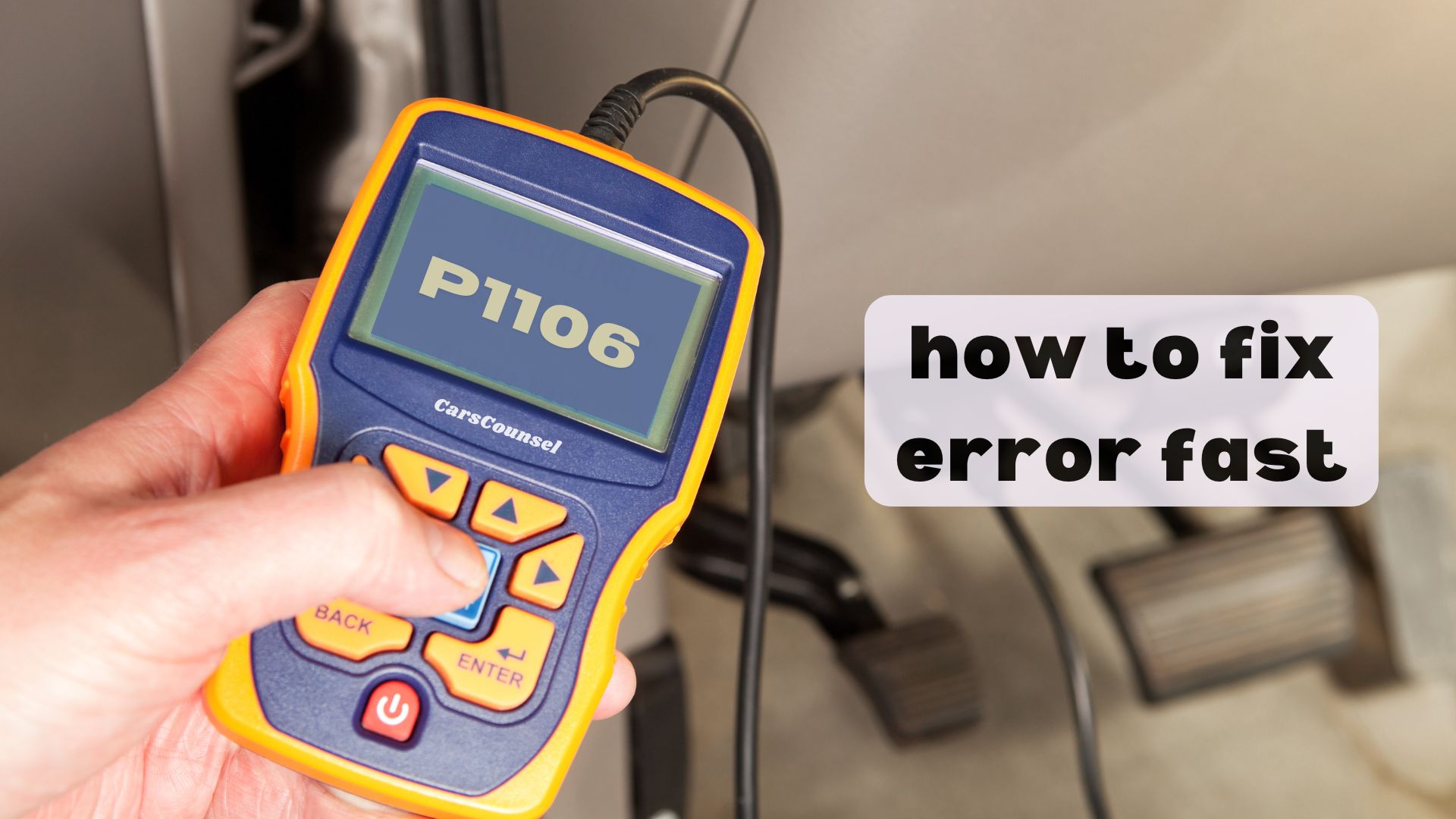It seems you’re about to encounter a bit of a “technical speed bump” with the P1106 code. This error code indicates a Barometric Pressure sensor issue, where the sensor’s output is outside the expected range. You’ll likely notice decreased fuel efficiency and rough engine performance.
As you investigate this further, you’ll discover that faulty sensors, wiring issues, and vacuum leaks are common culprits. But what’s the best way to tackle this problem?

Quick Navigation
Key Takeaways
- P1106 code indicates a Barometric Pressure sensor issue.
- Faulty sensors or wiring can trigger this code.
- Symptoms include decreased fuel efficiency and rough idling.
- Diagnosis involves inspecting sensor wiring and output.
- Repair requires sensor replacement and calibration.
P1106 Code Description and Implications
The P1106 code indicates a problem with the Barometric Pressure (BARO) sensor’s range or performance, signaling that the sensor’s output is outside the expected range.
This issue affects engine control efficiency, as the sensor measures atmospheric pressure to guarantee proper fuel-air mixture.
Poor sensor performance can lead to decreased fuel efficiency and engine performance issues like rough idling or hesitation.
Understanding the implications of this code is vital for addressing potential engine problems and maintaining ideal vehicle operation.
Common Causes of the P1106 Code
When diagnosing a P1106 code, you’re dealing with a complex interplay of factors that can cause your vehicle’s barometric pressure sensor to malfunction.
Common causes include faulty barometric sensors, wiring issues, and vacuum leaks.
Atmospheric pressure changes due to altitude or weather can also affect sensor performance.
Different barometric sensor types may have varying sensitivities to these conditions.
Understanding these factors is essential for accurate diagnosis and repair, ensuring ideal engine performance and fuel efficiency.
Symptoms Associated With P1106
If your vehicle’s barometric pressure sensor is malfunctioning, as indicated by the P1106 code, you’ll likely notice several symptoms that affect its performance.
These symptoms include decreased fuel efficiency, rough idling or stalling, and engine hesitation or surging. The Check Engine Light will also be illuminated, and you might experience difficulty starting the engine.
Identifying these symptoms is essential for understanding the performance impact of the P1106 code, which can significantly affect your vehicle’s overall operation and efficiency.
Proper symptom identification aids in diagnosing and addressing the underlying issue effectively.
Diagnosing the P1106 Trouble Code
Diagnosing the P1106 trouble code requires a systematic approach to identify the root cause of the issue.
You’ll need to use an OBD-II scanner to confirm the code and inspect the barometric pressure sensor and wiring for damage.
Testing the sensor’s voltage output against specifications is vital. Proper sensor calibration is essential for engine optimization, ensuring accurate atmospheric pressure readings.
If the sensor is faulty, replacing it will resolve the issue and improve engine performance.
Always consult a professional mechanic for precise diagnosis and repair.
Repairing the P1106 Issue
Repairing the P1106 issue involves a straightforward process once the diagnosis is complete.
You’ll need to replace the faulty barometric pressure sensor and guarantee proper wiring connections.
After replacement, perform sensor calibration to guarantee accurate readings.
Conduct performance testing to verify that the engine operates smoothly and efficiently. This may involve monitoring fuel efficiency and engine performance during various driving conditions.
Clear the trouble code using an OBD-II scanner and test drive the vehicle to confirm the repair’s success.
Cost Considerations for P1106 Repairs
When addressing the P1106 code, you’ll encounter varying costs depending on your vehicle’s make and model. Repair estimates typically range from $100 to $300, including parts and labor. Warranty coverage may apply if your vehicle is still under warranty.
| Component | Cost Range | Warranty Coverage |
|---|---|---|
| Sensor | $50-$150 | Possible |
| Labor | $50-$150 | Possible |
| Total | $100-$300 | Possible |
| Additional Repairs | Varies | Unlikely |
| Consultation | $50-$100 | Unlikely |
Prevention Strategies for Future Occurrences
After addressing the P1106 code and understanding the costs involved in repairs, you can take proactive steps to prevent future occurrences.
Implementing preventive maintenance is essential, such as regularly inspecting wiring and connections for damage. Additionally, ensuring proper sensor calibration can help maintain peak engine performance.
Regular checks on the intake system for vacuum leaks and monitoring atmospheric pressure changes due to altitude or weather conditions can also prevent issues.
Troubleshooting Tips and Best Practices
Troubleshooting a P1106 code requires a systematic approach to identify and address the root cause of the barometric pressure sensor issue. You should start by using an OBD-II scanner to confirm the code. Here are some key steps:
| Action | Description |
|---|---|
| Sensor Check | Inspect the sensor for damage. |
| Wiring Inspection | Look for wiring issues or poor connections. |
| Calibration | Consider sensor calibration if necessary. |
Ensure all electrical components are checked before replacing parts to avoid unnecessary repairs
More OBD-II Codes
| P1107 | P1118 | P1119 | P1121 |
| P1122 | P1123 | P1124 | P1125 |
| P1126 | P1127 | P1128 | P1129 |
| P1130 | P1132 | P1133 | P1134 |
| P1136 | P1135 | P1147 | P1148 |
| P1149 | P1150 | P1032 | P1153 |
Frequently Asked Questions
Can P1106 Cause Engine Failure?
You might face reduced engine reliability due to a sensor malfunction like P1106, but it typically doesn’t cause immediate engine failure. However, prolonged issues can lead to decreased performance and efficiency.
Is P1106 Specific to Certain Vehicles?
You’ll find the P1106 code in various vehicles, including Acura, Honda, and others, affecting both MAP and BARO sensor types. It’s not specific to one vehicle, impacting multiple models with similar sensor systems.
Can Weather Affect P1106 Codes?
You might experience P1106 issues due to weather fluctuations affecting atmospheric pressure, which can impact sensor readings. Changes in altitude or weather can trigger this code if the sensor or system is sensitive.
Does P1106 Impact Engine Performance?
As you face sensor malfunctions, you’ll notice engine performance issues. A faulty barometric pressure sensor can lead to decreased fuel efficiency and rough idling, significantly impacting your vehicle’s overall engine performance.
Can P1106 Be Fixed Without a Mechanic?
You can attempt DIY repairs for P1106 by troubleshooting the sensor and wiring. However, sensor replacement and complex issues may require professional assistance for accurate diagnosis and repair.
Conclusion
Fixing the P1106 code is like solving a puzzle—each piece must fit perfectly. The code often indicates a Barometric Pressure sensor issue, causing symptoms like poor fuel efficiency and rough idling. Diagnosing with an OBD-II scanner is essential. Repairs may involve replacing the sensor or addressing wiring issues. Proper calibration guarantees peak engine performance, much like fine-tuning a precision instrument.

